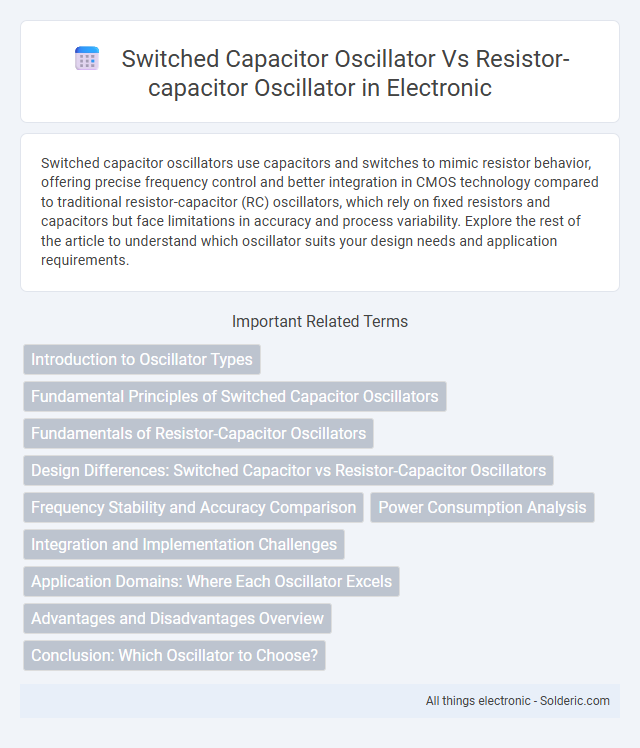Switched capacitor oscillators use capacitors and switches to mimic resistor behavior, offering precise frequency control and better integration in CMOS technology compared to traditional resistor-capacitor (RC) oscillators, which rely on fixed resistors and capacitors but face limitations in accuracy and process variability. Explore the rest of the article to understand which oscillator suits your design needs and application requirements.
Comparison Table
| Feature | Switched Capacitor Oscillator | Resistor-Capacitor (RC) Oscillator |
|---|---|---|
| Oscillation Mechanism | Switched capacitor network simulating resistance | Resistor and capacitor network |
| Frequency Control | Controlled by switching frequency (clock) | Controlled by resistor and capacitor values |
| Frequency Stability | High stability; less sensitive to process and temperature | Lower stability; affected by resistor and capacitor variations |
| Integration | Better for IC implementation; requires switches and clock | Simple to design but resistors may be area-consuming on IC |
| Power Consumption | Typically higher due to switching activity | Lower power in simple designs |
| Noise Performance | Lower noise due to switched capacitor filtering | Higher noise from resistor thermal noise |
| Applications | Precision timing, integrated filters, clock generation | General purpose oscillators, audio frequency generation |
Introduction to Oscillator Types
Switched capacitor oscillators utilize capacitors and switches to create precise frequency signals by mimicking resistor behavior, offering better frequency stability and integration in IC design. Resistor-capacitor oscillators rely on the RC time constant to set oscillation frequency, making them simpler but more susceptible to temperature variations and process changes. Your choice between these oscillator types depends on the required frequency accuracy, power consumption, and application environment.
Fundamental Principles of Switched Capacitor Oscillators
Switched capacitor oscillators operate by emulating resistive elements through rapid switching of capacitors at a fixed frequency, allowing precise frequency control independent of actual resistor values. The fundamental principle involves alternating the charge and discharge paths of capacitors using switches driven by a clock signal, creating an effective resistance that determines the oscillation frequency. This method enhances stability and reduces sensitivity to process variations compared to resistor-capacitor (RC) oscillators, which rely on physical resistor values and capacitor charging times for frequency generation.
Fundamentals of Resistor-Capacitor Oscillators
Resistor-capacitor (RC) oscillators generate sinusoidal waveforms by utilizing the phase shift created through RC networks to sustain oscillations at a specific frequency. The RC network, typically consisting of three cascaded RC sections, produces a total phase shift of 180 degrees, complemented by an additional 180-degree phase shift from an inverting amplifier to meet the Barkhausen criterion for sustained oscillations. These oscillators offer simplicity and ease of frequency tuning, though they generally exhibit lower frequency stability and precision compared to switched capacitor oscillators, which replace resistors with controllable switched capacitor elements for improved accuracy and integration in IC design.
Design Differences: Switched Capacitor vs Resistor-Capacitor Oscillators
Switched capacitor oscillators use a network of capacitors and switches controlled by a clock signal to emulate resistive behavior, allowing precise frequency control independent of transistor parameters and temperature variations. Resistor-capacitor (RC) oscillators rely on continuous-time resistors and capacitors, where frequency stability is affected by resistor tolerance, temperature coefficients, and process variations. The switched capacitor design enables integration in CMOS technology with improved accuracy and lower sensitivity to analog component mismatches compared to conventional RC oscillators.
Frequency Stability and Accuracy Comparison
Switched capacitor oscillators offer superior frequency stability and accuracy compared to resistor-capacitor oscillators due to their reliance on precise clock-driven charge transfer, which minimizes variations from temperature and component tolerances. Resistor-capacitor oscillators are more susceptible to frequency drift caused by resistor and capacitor value changes under temperature fluctuations and aging effects. Your applications demanding high precision benefit from switched capacitor designs, ensuring consistent oscillation frequency over time and environmental conditions.
Power Consumption Analysis
Switched capacitor oscillators typically exhibit lower power consumption compared to resistor-capacitor oscillators due to their reliance on switched capacitors instead of continuous resistive elements that dissipate static power. The dynamic nature of charge transfer in switched capacitor designs limits current flow, enhancing energy efficiency especially at low frequencies. When optimizing Your design for minimal power usage, considering the switched capacitor oscillator can offer significant advantages in ultra-low power applications.
Integration and Implementation Challenges
Switched capacitor oscillators excel in integration within CMOS technology due to their reliance on capacitors and switches instead of resistors, enabling precise frequency control and reduced area on-chip. Resistor-capacitor oscillators face challenges in integration because on-chip resistors consume significant silicon area and suffer from process variations impacting frequency stability. Your choice affects implementation complexity, with switched capacitor designs offering better scalability in modern integrated circuits despite requiring careful clock feedthrough management.
Application Domains: Where Each Oscillator Excels
Switched capacitor oscillators excel in integrated circuit applications requiring precise frequency control and low power consumption, such as in digital signal processing and clock generation for microprocessors. Resistor-capacitor oscillators are preferred in general-purpose analog circuits, including audio oscillators and simple waveform generators, due to their straightforward design and ease of implementation. Each oscillator type serves distinct application domains driven by frequency accuracy, power efficiency, and circuit complexity demands.
Advantages and Disadvantages Overview
Switched capacitor oscillators offer precise frequency control through digital clock signals, providing improved stability and integration in CMOS technology compared to resistor-capacitor oscillators. Resistor-capacitor oscillators benefit from simpler circuit designs and lower power consumption but suffer from higher sensitivity to component variations and temperature changes. The trade-off between accuracy and simplicity guides their use in applications demanding either precise timing or minimal power budgets.
Conclusion: Which Oscillator to Choose?
Switched capacitor oscillators excel in precise frequency control and stability, making them ideal for integrated circuits and applications requiring low power consumption. Resistor-capacitor oscillators offer simplicity, ease of design, and cost-effectiveness, better suited for general-purpose analog circuits where slight frequency variation is acceptable. You should choose a switched capacitor oscillator for high accuracy and integration, while a resistor-capacitor oscillator fits projects prioritizing simplicity and budget.
Switched capacitor oscillator vs Resistor-capacitor oscillator Infographic

 solderic.com
solderic.com